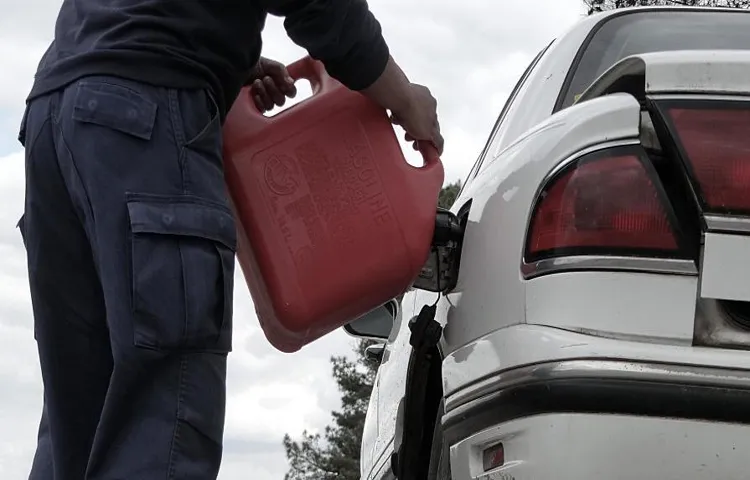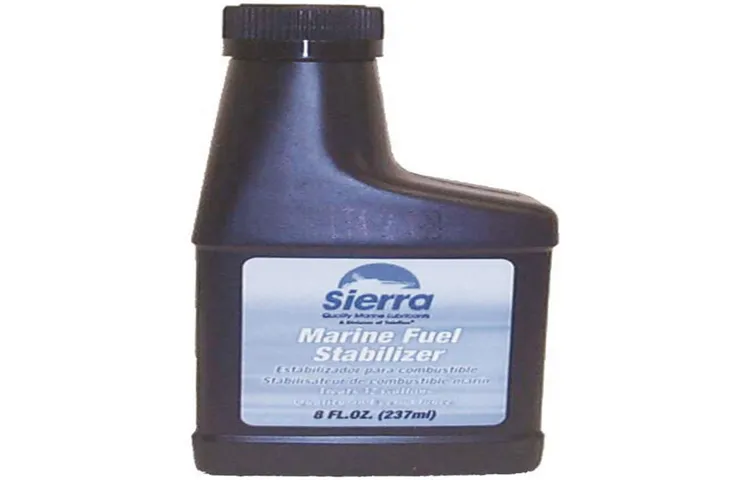Do you ever leave gasoline in your vehicle for an extended period of time? If so, you may have experienced the frustration of trying to start your engine only to find that the gas has gone bad. This is especially common during the winter months when cars are left sitting for long periods of time. Luckily, there is a way to prevent this problem: by adding gasoline stabilizer to your fuel.
In this step-by-step guide, we’ll show you how to add gasoline stabilizer to your tank, ensuring that your gasoline stays fresh and ready to use no matter how long it sits. So, buckle up and get ready to learn how to keep your engine running smoothly all year long!
Table of Contents
Why Use Gasoline Stabilizer?
If you’re wondering how to add gasoline stabilizer to your fuel tank, it’s actually a pretty simple process. A gasoline stabilizer can be incredibly beneficial to your vehicle’s fuel system by preventing the fuel from breaking down over time. This is especially useful if you don’t use your vehicle frequently or if you store it for long periods of time.
When gasoline breaks down, it can cause your fuel lines to clog and damage your engine over time. By adding a gasoline stabilizer to your fuel tank, you can extend the life of your engine and keep it running smoothly. Just be sure to follow the directions on the stabilizer bottle carefully to ensure the proper amount is added to your fuel tank based on its size.
So don’t wait until you start experiencing engine problems – add a gasoline stabilizer to your fuel today to keep your engine healthy and running well for years to come!
Increases Fuel Stability
Gasoline stabilizer is an effective way to ensure fuel stability and prevent varnish and gum buildup in your vehicle’s fuel system. It works by eliminating water and other harmful elements that can cause fuel breakdown and engine performance issues. A good gasoline stabilizer can keep fuel fresh for up to two years, which is especially useful for vehicles that are not driven regularly.
It also helps prevent corrosion and rust in fuel tanks and fuel lines. Using a gasoline stabilizer is a simple and cost-effective way to keep your engine running smoothly and avoid costly repairs. So why not use a gasoline stabilizer?

Improves Fuel Efficiency
Gasoline stabilizers are a great investment for anyone who wants to improve their fuel efficiency. These stabilizers are designed to keep gasoline fresh for longer periods, preventing the buildup of harmful chemicals that can clog the engine and reduce efficiency. By using a gasoline stabilizer, you’ll be able to keep your engine running smoothly and efficiently, which can ultimately save you money on your fuel costs.
Additionally, it can also help to prevent damage to your engine over time, ensuring that it continues to perform at its best. In short, using a gasoline stabilizer is a smart choice for anyone who wants to get the most out of their vehicle. By using this simple and effective tool, you can keep your engine running smoothly and efficiently for years to come.
When to Add Gasoline Stabilizer
Adding gasoline stabilizer is essential in preserving the quality and lifespan of your fuel. If you plan on storing your gas for an extended period, it is recommended to add gasoline stabilizer. This is because gasoline can begin to break down over time, causing sediment to accumulate and clog fuel filters.
To add gasoline stabilizer, simply pour the recommended amount, usually one ounce per gallon of gas, into the container before filling it up. It is important to ensure that the stabilizer is mixed throughout the fuel before use. Using gasoline stabilizer is especially crucial for seasonal equipment such as lawnmowers, boats, and snow blowers that are not used regularly, as it can prevent harmful and costly damages.
Don’t wait until the last minute to add gasoline stabilizer – taking proactive measures can ensure your fuel is always ready to go.
Before Storing Fuel for Long Periods
As a car owner, it’s essential to know when to add a gasoline stabilizer when storing fuel for an extended period. You may wonder how long a gasoline-stored fuel can last without stabilizer, but the answer isn’t straightforward. Gasoline can last up to six months without a stabilizer, but it largely depends on factors, including the gasoline’s quality and the temperature of the storage container.
However, if you’re storing fuel for over six months, adding a gasoline stabilizer becomes necessary. The stabilizer prevents the fuel from degrading by ensuring it keeps its original state, reducing oxidation and varnish formation. It also helps the fuel’s volatility, preventing starting problems and wastage.
Before storing fuel, check the fuel tank’s condition and ensure it’s empty, dry, and free of contaminants. Then, add the right amount of gasoline stabilizer as per the manufacturer’s instructions, ensuring thorough mixing. With gasoline stabilizer, you can store your fuel with confidence for an extended period.
After Refueling Equipment for Seasonal Storage
One important step in preparing your equipment for seasonal storage is refueling. But when should you add gasoline stabilizer to the fuel tank? Ideally, it’s best to add the stabilizer when you initially fill up the tank. This ensures that the stabilizer mixes well with the gasoline and provides maximum protection against the effects of ethanol and other additives.
However, if you’ve already filled up the tank and forgot to add stabilizer, you can still do so before storing it for the season. Simply add the recommended amount of stabilizer to the fuel tank, then run the engine for a few minutes to allow the stabilizer to circulate through the fuel system. This will help prevent the buildup of deposits and keep your engine running smoothly when you take it out of storage.
Remember, taking a few extra steps to properly prepare your equipment for storage can save you a lot of time and money in the long run.
Preparing to Add Gasoline Stabilizer
Adding a gasoline stabilizer is a crucial step in keeping your fuel fresh and ready to use, especially if it’s been sitting idle for some time. But before you add the stabilizer, make sure that your fuel tank is clean and free from any sediment or debris. You don’t want to mix the stabilizer with any contaminants that could potentially damage your engine over time.
Once you’ve confirmed that your fuel tank is completely clean, it’s time to treat it with the appropriate amount of stabilizer. Most gas stabilizers come with instructions that recommend a certain ratio of stabilizer to fuel, usually one ounce per two-and-a-half gallons of gasoline. Make sure to pour the stabilizer slowly and mix it thoroughly with the fuel, using a funnel to avoid any spills or splashes.
Remember that adding a gasoline stabilizer is a simple yet crucial step in maintaining the overall health and performance of your engine, so take the time to do it right.
Choose the Correct Stabilizer
When it comes to storing gasoline for long periods of time, it’s essential to add a gasoline stabilizer to prevent deterioration and maintain its quality. But, choosing the correct stabilizer can be confusing, as there are numerous options available in the market. It’s crucial to determine which type of stabilizer is best suited for the specific application.
For instance, if storing gasoline in a lawnmower, go for a stabilizer that has a high octane rate and protects against ethanol corrosion. Similarly, for boats, choose a stabilizer that provides long-term protection against gum, varnish, and moisture. It’s vital to research and read product labels before buying a stabilizer, and ensure it matches with the type of gasoline and the application.
An error in choosing the correct product could lead to engine damage or decreased fuel efficiency. Thus, taking the time to find the right stabilizer is a small investment that could save time and money in the long run.
Consult the User Manual
Consulting your user manual is one of the best habits that you can adopt when preparing to add gasoline stabilizer to your fuel tank. Gasoline stabilizers are additives designed to maintain the quality of fuel while preventing engine problems that may arise due to the use of old or degraded gasoline. To maximize the effectiveness of the stabilizer, you need to know the right amount that you need to add to your fuel and other instructions provided in the user manual.
The manual is the best source of information that can assist you in properly adding the stabilizer to your fuel and ensure that your engine remains protected and functioning smoothly. Before adding anything to your engine, it’s always beneficial to check out the user manual instructions first to avoid any damages or mistakes. With the right information, you can easily manage your fuel additives and enjoy an efficient engine that runs smoothly and performs better.
Adding Gasoline Stabilizer
If you’re wondering how to add gasoline stabilizer to your fuel, the good news is that it’s a relatively simple process. Gasoline stabilizers are designed to help prolong the life of your fuel by preventing evaporation and oxidation. This can be especially important if your vehicle is going to be sitting idle for an extended period of time, as stale fuel can cause engine damage.
To add a gasoline stabilizer, simply pour the recommended amount into your fuel tank before filling it up with gasoline. Be sure to check the label for instructions on the recommended dosage, as using too much can actually have a negative effect on your engine. Remember, adding a gasoline stabilizer is a quick and easy way to help keep your fuel fresh and prolong the life of your engine.
Pour Stabilizer into Fuel Tank
Adding gasoline stabilizer is an essential step to maintaining your fuel tank and prolonging the life of your engine. As gasoline ages, it can start to degrade and form varnish and deposits that can clog fuel lines and damage your engine. This is where a gasoline stabilizer comes in.
When you pour gasoline stabilizer into your fuel tank, it will help preserve the quality of your fuel and prevent it from breaking down. Not only that, but a stabilizer can also help prevent corrosion in your fuel system, which can save you from costly repairs in the future. It’s easy to use, too.
Simply pour the recommended amount into your fuel tank and let it mix with the gasoline. Remember to always follow the manufacturer’s instructions for best results. With gasoline stabilizer, you can ensure that your engine will run smoothly and reliably whenever you need it to.
Run Engine for Several Minutes
When it comes to maintaining your engine, adding a gasoline stabilizer can work wonders in keeping it running smoothly for years to come. Before adding the stabilizer, it’s important to run the engine for several minutes to ensure that the gasoline is thoroughly mixed with the stabilizer. This step allows the stabilizer to get into every part of the engine, protecting it from harmful rust and corrosion.
It also helps to prevent the fuel from breaking down and turning into a sludgy mess over time. Think of it like adding vitamins to your diet – by taking them regularly, you’re ensuring that your body has all the nutrients it needs to stay healthy. In the same way, adding a gasoline stabilizer to your engine is like giving it a vitamin boost, keeping it healthy and running smoothly for years to come.
So, remember to add gasoline stabilizer to your engine and be sure to run it for several minutes before shutting it off to keep your engine in top shape.
Tips for Using Gasoline Stabilizer
Adding gasoline stabilizer to your fuel tank is an important step to ensure the longevity of your engine. But how do you use it properly? First, you need to purchase a high-quality stabilizer from a trusted brand. Once you have the stabilizer, open your fuel tank and add the appropriate amount according to the instructions on the label.
Be sure to shake the fuel tank well to distribute the stabilizing chemicals throughout the fuel. It is also essential to use fresh gasoline before adding the stabilizer to get the best results. Remember to use the stabilizer before storing your vehicle for a prolonged period.
By following these simple steps, you can ensure that your engine is protected from harmful ethanol and other factors that can cause fuel system issues. Remember, adding gasoline stabilizer is an investment in the health of your engine that can save you money in the long run.
Use a Funnel to Avoid Spills
Gasoline stabilizer Are you tired of finding your gasoline deteriorating over time? Gasoline stabilizer can be a lifesaver when it comes to keeping your gasoline fresh for a longer period of time. To use it effectively, there are a few key tips to keep in mind. Firstly, always read the instructions on the bottle as different stabilizers may have different requirements.
Secondly, use a funnel when pouring the stabilizer into your gasoline tank to avoid any spills. This not only ensures your safety but also prevents any harmful effects on the environment. Lastly, make sure to shake your gasoline tank thoroughly after adding the stabilizer to ensure it’s well-mixed.
Overall, using a gasoline stabilizer is a worthwhile investment that can save you money in the long run and prevent any unwanted engine problems. So, don’t forget to add it to your maintenance routine!
Check Expiration Date of Stabilizer
Gasoline stabilizer Gasoline stabilizers are an essential tool for anyone who stores gasoline for any length of time. They prevent oxidation, gumming, and the formation of varnish, which can hinder your engine’s performance. Using a gasoline stabilizer can save you money in the long run by extending the life of your gasoline and preventing costly repairs.
When buying a gasoline stabilizer, it’s important to check the expiration date, as an expired stabilizer won’t be effective. Make sure to follow the instructions for the correct amount of stabilizer per gallon of gasoline. Additionally, consider using a fuel stabilizer that includes a fuel treatment.
This can increase the cleaning power of your fuel and prevent any buildup in the fuel system. Always remember to keep your gasoline storage container tightly sealed and stored in a cool, dry place. By following these tips, you can ensure that your gasoline stays fresh and ready to use whenever you need it.
Store Stabilizer in a Cool, Dry Place
Gasoline Stabilizer When it comes to storing gasoline for any length of time, gasoline stabilizer is a must-have item to keep on hand. Gasoline can degrade over time, causing it to become less efficient and even damage your engine. Using gasoline stabilizer will help prevent this from happening by keeping the fuel fresh and stabilizing it.
One of the most important tips for using gasoline stabilizer is to store it in a cool, dry place. This will ensure that the stabilizer will remain effective and not break down before you have a chance to use it. In addition, it is important to follow the instructions on the bottle carefully and use the correct amount of stabilizer for the amount of gasoline you are storing.
With these tips in mind, you can be confident that your gasoline will remain fresh, and your engine will be protected from damage, even if it is stored for an extended period of time. So, if you plan to store gasoline for any length of time, don’t forget to add gasoline stabilizer to your list of essential items!
Conclusion
In conclusion, adding a gasoline stabilizer to your fuel tank is like giving your gas the superhero power of endurance. It allows your fuel to withstand the tests of time and weather, ensuring its freshness and quality for when you need it most. So, don’t let your gas run out of steam.
Give it a boost with a gasoline stabilizer and let it become the unstoppable force it was meant to be!”
FAQs
What is a gasoline stabilizer and what does it do?
A gasoline stabilizer is a chemical additive that helps to prevent the degradation of gasoline over time and prolong its shelf life. It also helps to prevent the formation of gums and varnishes in fuel systems.
How do I use a gasoline stabilizer?
Simply add the recommended amount of stabilizer to your fuel tank before filling up with gasoline. Be sure to follow the instructions on the packaging for the correct dosage.
How long does a gasoline stabilizer last?
The effectiveness of a gasoline stabilizer can vary depending on the brand and the storage conditions of the gasoline. In general, most stabilizers can keep gasoline fresh for up to 12 months.
Can a gasoline stabilizer improve fuel efficiency?
A gasoline stabilizer is designed to maintain the quality of gasoline over time, but it does not have any significant impact on fuel efficiency.
Is it necessary to use a gasoline stabilizer if I don’t store fuel for long periods of time?
While it is not absolutely necessary to use a gasoline stabilizer if you don’t store fuel for long periods of time, it can still be beneficial to use one to protect your fuel system and ensure your gasoline stays fresh.
Can a gasoline stabilizer fix a fuel system that is already clogged with varnish or gum deposits?
Unfortunately, a gasoline stabilizer cannot repair a fuel system that is already clogged with varnish or gum deposits. In such cases, a more thorough fuel system cleaning may be necessary.
Can I use a gasoline stabilizer in diesel fuel?
No, gasoline stabilizers are specifically formulated for gasoline and should not be used in diesel fuel. There are separate diesel fuel stabilizers available for diesel engines.



